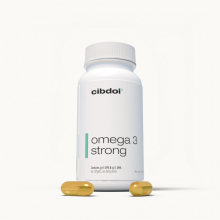Does Milk Have Omega-3 Fatty Acids?
Published:
Milk provides protein, vitamins and minerals like calcium, phosphorus and B12. But when it comes to heart-healthy fats, does milk actually contain omega-3s?
Contents:
The answer is that regular milk contains only tiny traces of omega-3 fatty acids. However, some milk products like butter, cheese, and ice cream do provide small amounts since they contain milk fat.
Additionally, some milk is enriched with omega-3s during processing. Overall though, standard milk is not considered a significant source of omega-3 fats.
This article will cover the omega-3 content of different types of dairy milk, how much you need, and better dietary sources to meet your daily requirements.

Omega-3s in Regular Milk
Whole milk averages around 3.25% milk fat, while 2% milk contains 2% fat and skim milk has minimal fat content.
The small amount of milk fat in whole milk provides omega-3s as follows (1):
- 1 cup (237 ml) whole milk has:
- Calories: 146
- Total fat: 8 grams
- Saturated fat: 4.6 grams
- Protein: 8 grams
- Calcium: 276 mg (28% DV)
- Vitamin D: 124 IU (31% DV)
- Omega-3s: 24 mg
So one cup of whole milk contains just 24 mg of omega-3 fatty acids. Reduced fat and skim milk provide even less since their fat content is lower.
For comparison, the same 1 cup (237 ml) serving of soy milk naturally contains (2):
- Calories: 105
- Total fat: 4 grams
- Protein: 8 grams
- Calcium: 301 mg (30% DV)
- Vitamin D: 101 IU (25% DV)
- Omega-3s: 92 mg
While neither provides huge amounts, soy milk naturally offers about 4 times more omega-3s than regular cow’s milk.
Some milks are enriched with omega-3s during processing, which is indicated on the label. Otherwise, standard milk is not a significant source.
Why Omega-3s Matter
Before discussing which foods offer omega-3s, let’s cover why these fats are so important for health:
Heart Health
Omega-3 fatty acids provide major benefits for your heart. They:
- Lower triglycerides - High levels increase risk of heart disease (3).
- Reduce blood pressure - Omega-3s act as a natural blood thinner (4).
- Prevent plaque buildup - Decreases fatty deposits inside arteries (5).
- Reduce irregular heart beats - Linked to lower risk of sudden cardiac death (6).
- Improve cholesterol - Omega-3s raise “good” HDL and lower “bad” LDL (7).
Brain Health
Omega-3s also play vital roles in brain function and development:
- Enhance memory and thinking - Linked to better cognition in adults (8, 9).
- Fight depression - Associated with lower rates of depression (10).
- Aid fetal brain development - DHA is vital for babies’ brain growth (11).
- Support healthy aging - Helps prevent cognitive decline as we age (12).
Eye Health
Omega-3s support eye health and vision:
- Reduce macular degeneration - A major cause of blindness (13).
- Treat dry eye disease - Improve tear production and quality (14).
- Benefit babies’ vision - Higher omega-3 intake in pregnancy reduces vision problems (15).
Anti-Inflammatory Effects
Omega-3s are powerful anti-inflammatory agents that can:
- Lower inflammation - Reduce inflammatory markers like C-reactive protein (16).
- Relieve joint pain - Decrease swelling and stiffness in rheumatoid arthritis (17).
- Benefit autoimmune conditions - Shown to help lupus, eczema, IBD and psoriasis (18).
Clearly, omega-3 fatty acids are incredibly beneficial for nearly all aspects of health. But how much do you actually need to obtain these benefits?
Omega-3 Recommendations
Major health organizations recommend getting at least 250–500 mg daily of the omega-3s EPA and DHA combined for optimal health (19, 20).
Higher intakes up to 2,000 mg per day are sometimes suggested for people with heart disease, high triglycerides or metabolic syndrome risk factors (21).
Pregnant and breastfeeding women need at least 300–900 mg of DHA daily for proper fetal brain and eye development. The amount varies based on age for children (22).
Vegans and vegetarians may require more omega-3s than average due to low intakes from plant foods (23).
The tiny amount of omega-3s in milk fall well below these daily targets. To get sufficient omega-3s, you need to look to other foods.
Top 10 Dietary Sources of Omega-3s
Here are the top 10 foods that provide beneficial omega-3 fatty acids:
1. Oily Fish
Salmon, mackerel, sardines and herring are high in anti-inflammatory EPA and DHA omega-3s. Just 3 ounces (85 grams) of salmon provides over 1,000 mg (24).
2. Fish Oil
Fish oil capsules provide concentrated doses of EPA and DHA. Many supplements provide 500–1,000 mg per serving. Algal oil is a vegetarian alternative.
3. Chia Seeds
Chia seeds deliver 5 grams of plant-based ALA omega-3s in just 1 ounce (28 grams) (25).
4. Flaxseeds
Flaxseeds provide 2,300 mg of ALA per ounce (28 grams) (26).
5. Walnuts
Walnuts contain 2,500 mg of ALA per ounce (28 grams) (27).
6. Soybeans
Soybeans, edamame, tofu and tempeh contain ALA. Half a cup (170 grams) of soybeans has nearly 1,000 mg (28).
7. Hemp Seeds
Hemp seeds offer 1,200 mg of plant-based ALA per ounce (28 grams) (29).
8. Brussels Sprouts
Brussels sprouts provide 135 mg ALA per half cup (44 grams) (30).
9. Algal Oil
Algal oils supply vegan EPA and DHA from marine algae.
10. Beans
Kidney beans, chickpeas and other beans contain ALA. One cup of kidney beans has 430 mg (31).
Aiming to include these omega-3-rich foods daily ensures you meet your requirements.
Healthiest Milk Options
While milk is not a good omega-3 source, some types make healthier choices than others:
Low-Fat or Skim Milk
Lower fat milk has fewer calories and less artery-clogging saturated fat than whole milk. Choose 1% or skim.
Organic Milk
Organic milk comes from cows not treated hormones or antibiotics. It contains more beneficial omega-3s than conventional milk.
Enriched Milk
Look for milk enriched with EPA, DHA or flax oil. Try brands with at least 250 mg omega-3s per serving.
Soy, Almond or Oat Milk
Plant-based milks like soy, almond and oat milk are naturally higher in omega-3s than dairy milk. Check for added EPA/DHA.
Grass-Fed Milk
Grass-fed milk has a better fatty acid profile with more omega-3s and antioxidants than standard milk.
While they don’t provide large amounts, some milk options boast slightly more omega-3s than regular milk.
Healthy Ways to Enjoy Milk
Here are some nutritious ways to incorporate milk into your diet:
- Enjoy a glass of low-fat milk with breakfast.
- Use milk instead of water when making oatmeal, soups or smoothies.
- Combine milk with coffee or tea.
- Make a fruit smoothie with milk, banana and berries.
- Whip up homemade hot chocolate with cocoa powder and warm milk.
- Blend milk into protein shakes along with fruits, veggies and nut butters.
- Bake milk into custards, puddings or chia pudding.
- Mix into French toast or pancake batter.
While milk doesn’t provide significant omega-3s, it can be part of a healthy, balanced diet when consumed in moderation. Focus on low-fat and omega-3-enriched options.
Getting Your Omega-3s Without Milk
You don’t need milk to get omega-3 fatty acids. There are many other simple ways to meet your daily needs, including:
- Eating fatty fish like salmon 2–3 times per week.
- Taking fish, krill or algae oil supplements.
- Snacking on walnuts, pecans, hazelnuts and other omega-3-rich nuts.
- Adding chia and hemp seeds to smoothies, oats and yogurt.
- Cooking with omega-3-rich oils like canola, soybean and olive oil.
- Enjoying omega-3-rich beans like kidney beans, chickpeas and white beans.
With some planning, it’s easy to meet your omega-3 intake even if you don’t drink milk.
Key Takeaways on Milk and Omega-3s
Here are some key points on milk and its omega-3 fatty acid content:
- Regular milk only provides tiny amounts of omega-3s.
- Whole milk has slightly more than 2%, 1% or skim milk.
- Some dairy products like cheese, ice cream and butter contain omega-3s from milk fat. But amounts are still minimal.
- Fortified milk, soy milk, rice milk and other plant-based milks provide more omega-3s.
- You need at least 250–500 mg omega-3s daily. Milk alone won’t provide this.
- Focus on fatty fish, oils, nuts, seeds and beans as your omega-3 sources.
Overall, milk should not be relied on as a meaningful source of omega-3 fatty acids. Prioritize other omega-3-rich foods instead.
Frequently Asked Questions
Here are the answers to some common questions about the omega-3 content of different types of milk:
Does goat milk have more omega-3s than cow milk?
Goat milk provides a similar amount of omega-3s to cow milk. Neither contains significant amounts compared to fatty fish and other foods.
Is sheep milk higher in omega-3s?
Sheep milk has slightly more omega-3s than goat or cow milk. But the levels are still low compared to much better sources.
What about raw milk?
Raw, unpasteurized milk from grass-fed cows contains slightly more beneficial fats like omega-3s than standard pasteurized milk. But the levels remain minimal overall.
Do milk alternatives like rice milk have EPA and DHA?
Most plant-based milks only contain the omega-3 ALA naturally. However, many brands enrich rice, soy, almond and oat milks with EPA and DHA from marine oils.
Is chocolate milk a good source of omega-3s?
The small amount of milk fat in chocolate milk provides a bit of ALA omega-3. But the quantity is very low compared to better sources.
What about omega-3 enriched yogurt?
Some yogurts have added fish oil or microalgae oil. These can help you meet your daily omega-3 needs if they contain at least 250-500 mg of DHA/EPA per serving.
Rely primarily on fatty fish, plant oils, nuts, seeds and fortified foods to meet your omega-3 needs. Enjoy milk and dairy in moderation as part of an overall healthy diet.
The Bottom Line
Regular milk only provides minimal amounts of ALA omega-3 fat and little to no EPA or DHA. To meet the 250–500 mg daily target for optimal health, you would need to drink a large quantity of milk, which isn’t recommended. Instead, focus on getting your omega-3s from fatty fish, fortified foods like milk alternatives and omega-3 supplements.















